Banding Western Snowy Plovers May Bring Them Back From The Brink In California
Have you ever noticed a banded bird in the wild and wondered who banded them, why, and what the colors mean? For residents of the west coast, there is a minuscule shorebird for which these bands could mean the difference between survival and extinction of the species in California.
The western snowy plover is about the size of a sparrow and weighs less than a tennis ball. Its pale tan and white coloration allows it to blend into the sandy beaches it calls home. In fact, as I walked across a beach one afternoon a couple years ago, it took me a moment to figure out that the odd blurs skitting across the sand were snowy plovers and not figments of my imagination. When I realized what the faint movement was, I looked around and saw dozens of snowy plovers darting across the sand catching invertebrates and chasing rivals away from their zone.
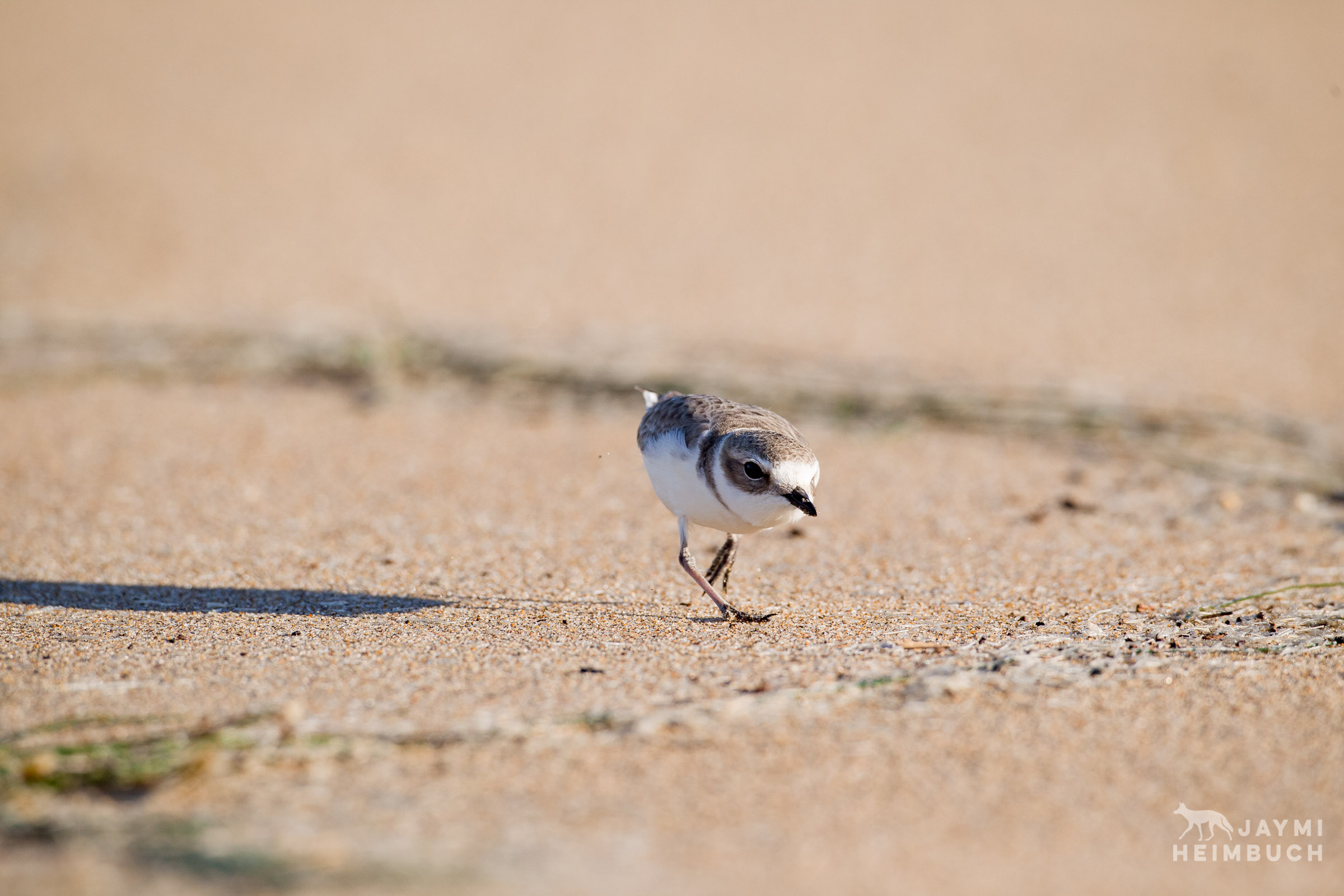
Snowy plovers, despite their dainty size, are charismatic and fierce little birds. They seem fluffy and cute at first but watch them zero in on prey or flush a competitor away from their nest and you’ll see a distinct hint of dinosaur in them.
Dunes and flat beaches are the preferred habitat for the species. Unfortunately, that is also a preferred habitat for humans. Habitat loss and the degradation of habitat has been a key factor in the dramatic decline of the western snowy plover.

This is especially the case in the Bay Area of California. San Francisco used to be mostly a vast network of sand dunes, which was home to a surprising diversity of wildlife, including large numbers of snowy plovers. In a relatively short period of time, the city pushed farther west until it covered the entire peninsula, destroying miles of important habitat.
Habitat loss has occurred all along the coast. Once a common bird from Washington to Baja, the Pacific coast population plummeted until 1993 when it was federally listed as a threatened species. The population stabilized and began a slow increase starting 2000.
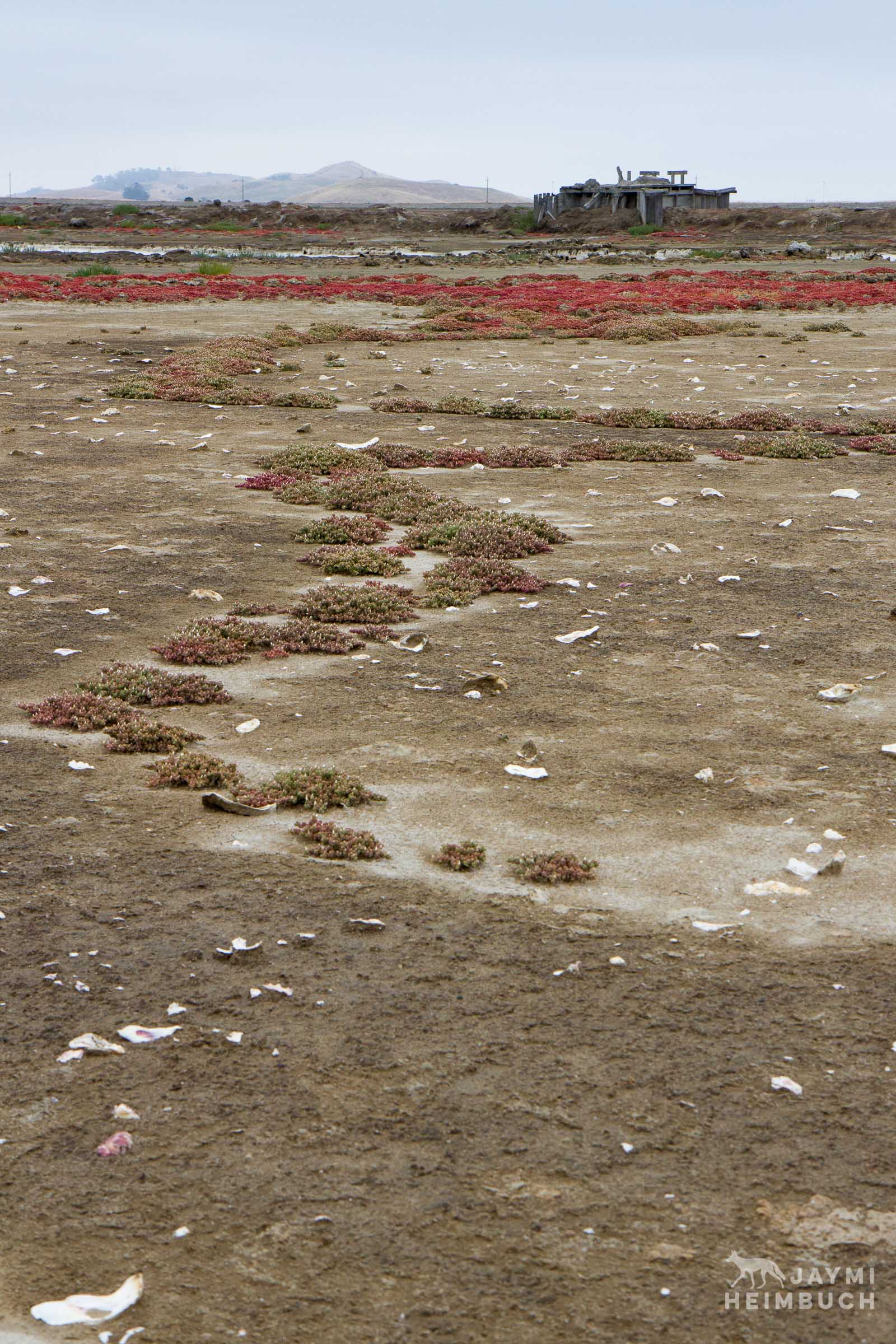
According to Pacific Blue, somewhere around 1,500 snowy plovers nest along California’s beaches. And a very small population of them nest in an area on the east side of the San Francisco Bay in what was once salt ponds owned by Cargill.
In 2003, The California Department of Fish and Game gained ownership of the land and has been steadily restoring the area in what is one of the largest wetland restoration projects in the history of the San Francisco Bay area. The Eden Landing Ecological Reserve is 600 acres of flat, open land sprinkled with wetland vegetation, the remnants of the old salt-making structures, and importantly, oyster shells.
The old salt flats have been peppered with oyster shells in an effort to camouflage western snowy plover nests and hide them from predators such as gulls and ravens.
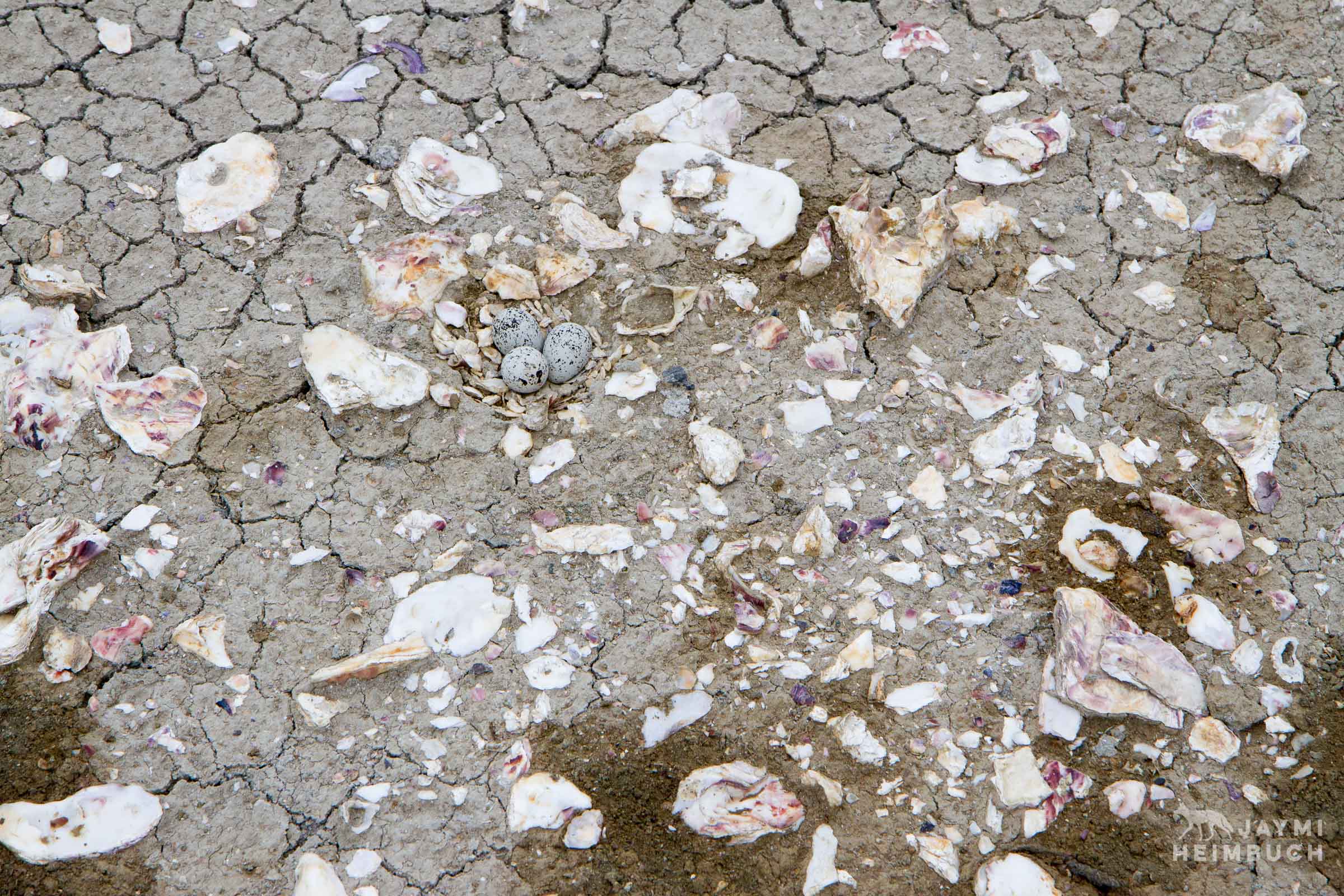
While some bird species go to great lengths to hide their nests, the snowy plover likes to take the hidden-in-plain sight approach. Selecting sand dunes, shorelines and flat land such as this, they will turn the slightest of indentations in the ground into a nest site. Their eggs are camouflaged to blend in like rocks or speckled sand. And that coloration is all they rely on to protect their eggs from predators, or even unintentional casualties like recreational vehicles driving across the sand dunes.
The choice of nesting site is likely one of the reasons the chicks are precocious, ready to up and run from the nest site and keep up with the parent within just a couple hours of hatching. As soon as their feathers are dry and they’ve rested from the enormous effort they put into breaking from their shell, they’re off and foraging for food. It is during this one or two hour window between hatching and mobility that researchers have the best chance of banding snowy plovers.
A few years ago, I and another wildlife photographer, Rebecca Jackrel, were able to tag along behind Caitlin Robinson-Neilson, who was then with the San Francisco Bay Bird Observatory, as she did her morning rounds checking known plover nests for signs of hatching and, if there were new chicks, banding the tiny fluffy birds.
With an early start to the day, Researcher Caitlin Robinson-Neilson gets supplies for banding birds form her car.
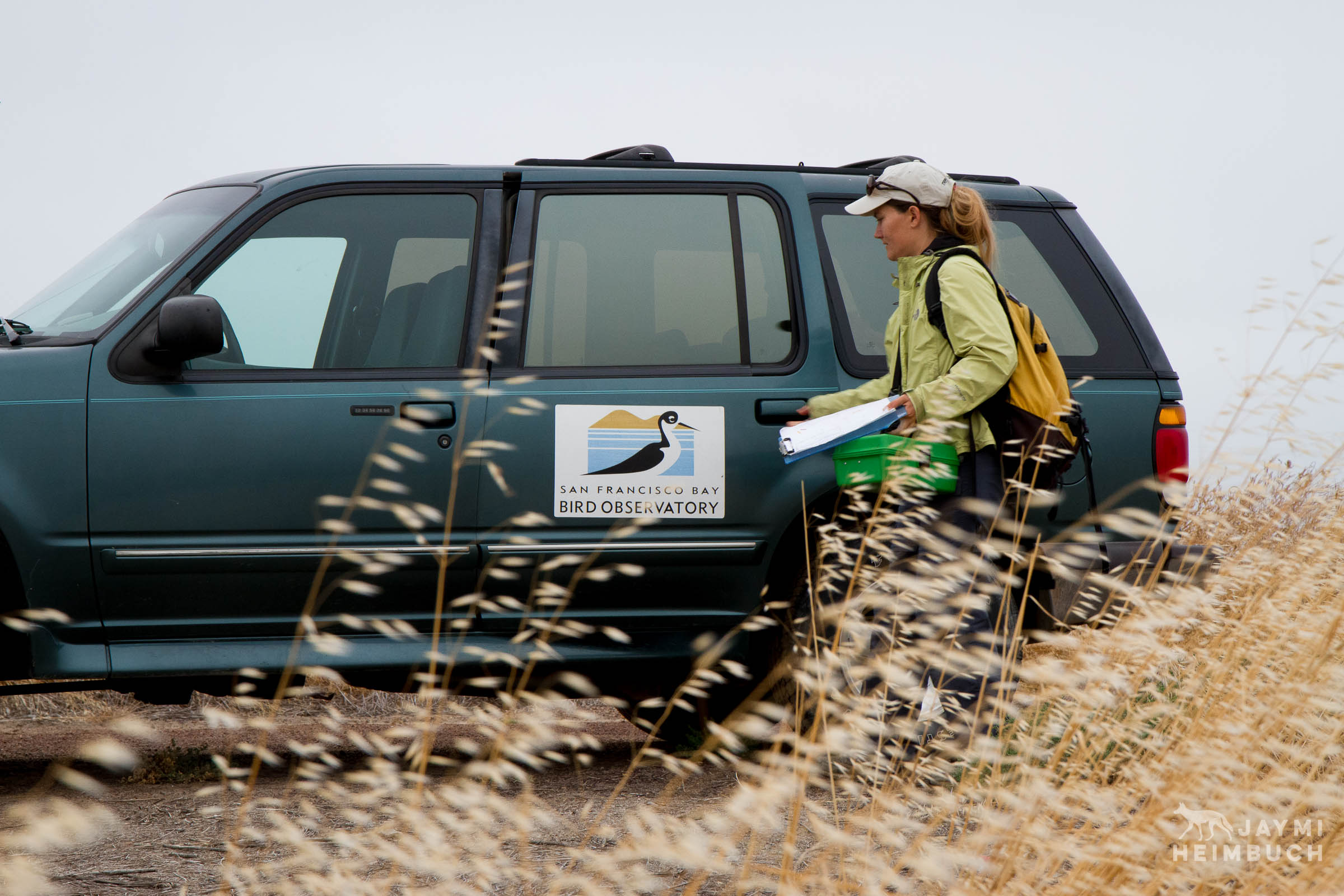
The old Cargill Salt Ponds have been turned into an ecological reserve called the Eden Landing Ecological Reserve. Access is restricted to help protect nesting western snowy plovers and other aspects of the sensitive habitat.
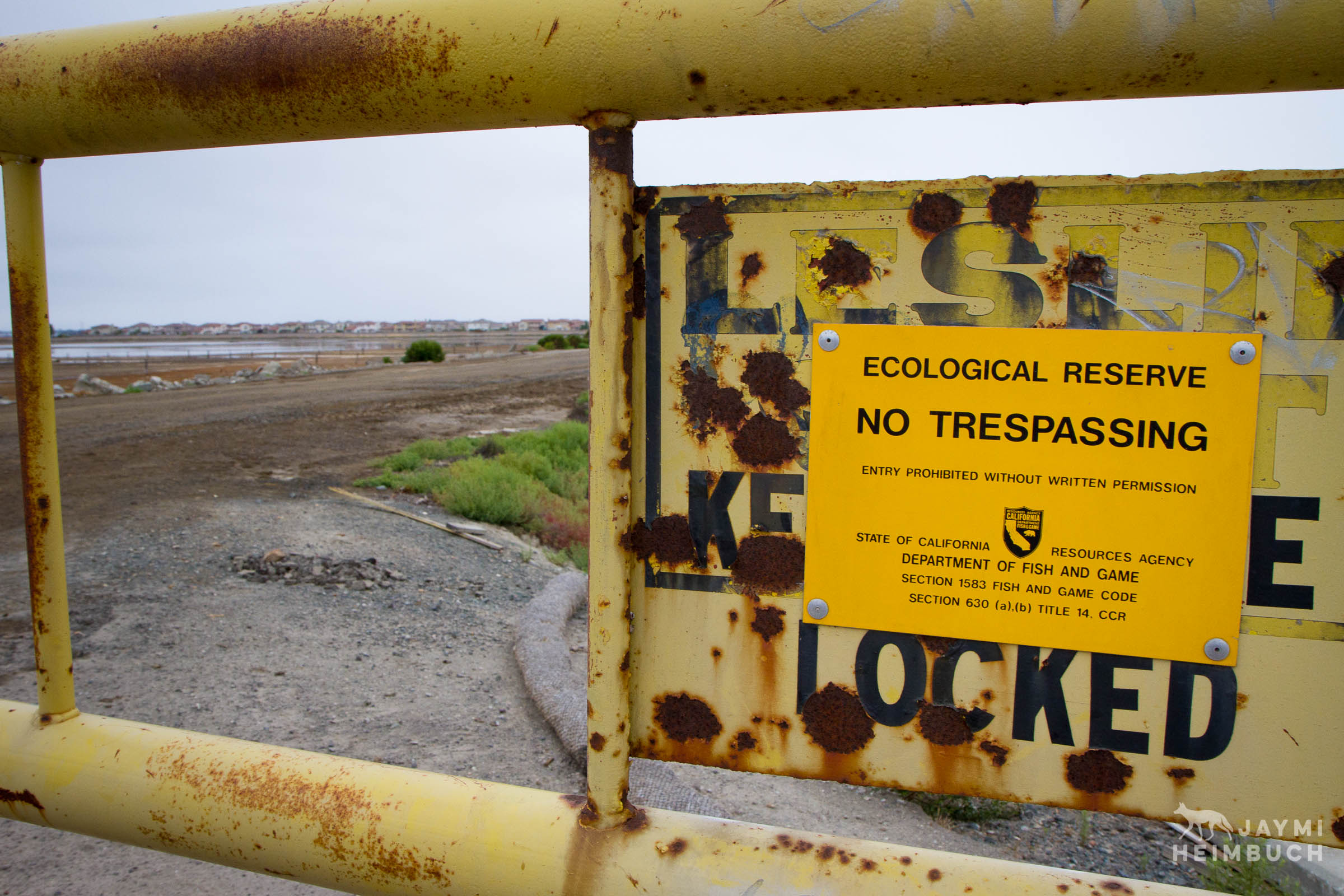
Robinson-Neilson checks that the nest cam is working properly. This allows researchers to monitor the nests without disturbing the birds, and also provides a chance to see what might predate the nests, how, and when so that strategies for protecting nests can be put into place.
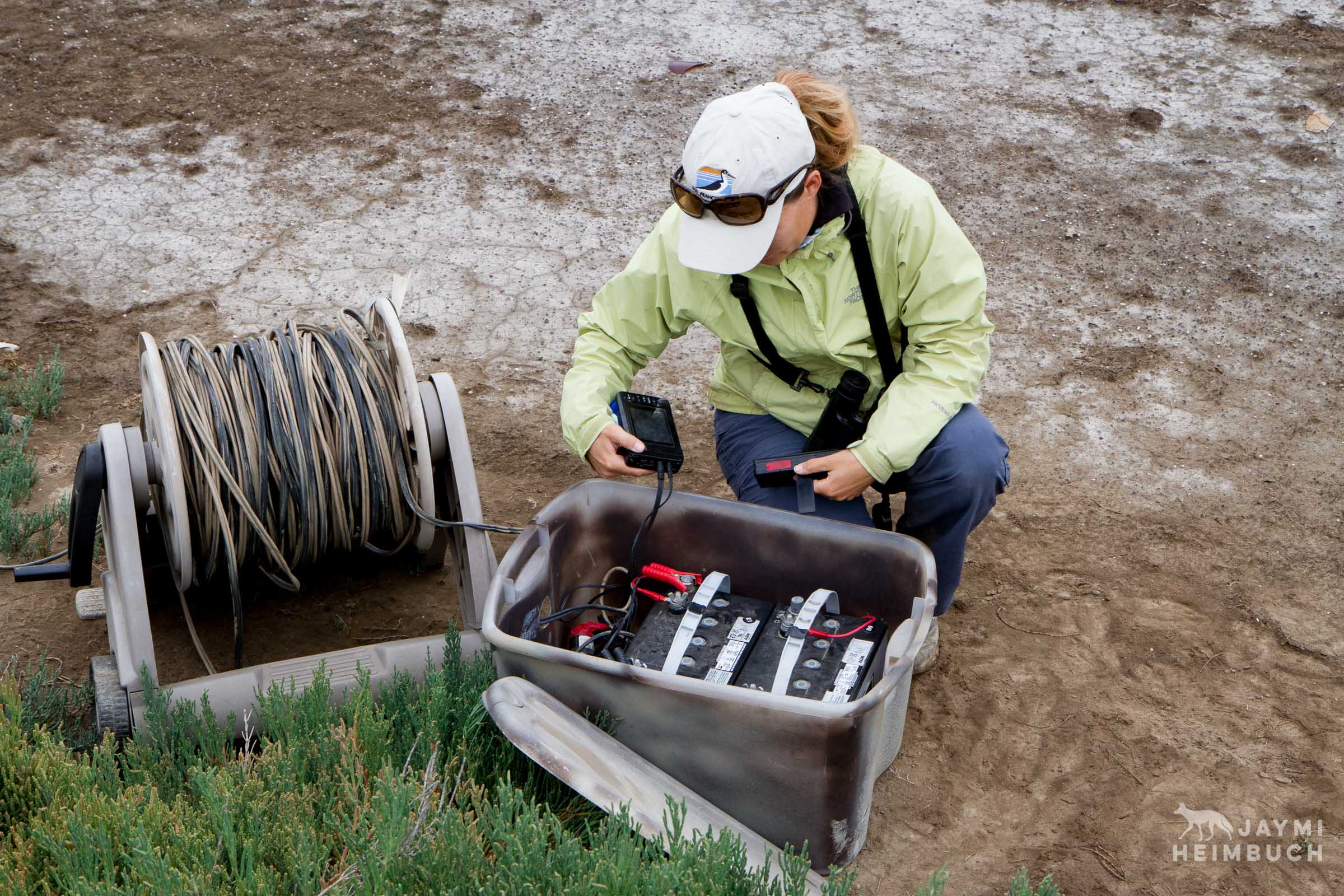
The first nest we checked had two whole eggs and one egg broken open with a tiny, tired, still wet chick next to it. Excited that we’d caught this nest at the beginning of the window needed for banding, we retreated to give the chick time to rest and warm up with its mother, who was around 40 yards away and looking on with apparent concern.
We continued with Robinson-Neilson’s rounds checking on the other nests. For the nests that were nearing their expected hatching dates, Robinson-Neilson would hold each egg up to her ear to listen for sounds of peeping or tapping, which are tell-tale signs a chick is beginning to work its way out. Several other nests that weren’t yet close to their hatching dates all, thankfully, still had their eggs.
After around perhaps half an hour, we returned with the tool kit for banding the first chick which would be dry and rested by now.
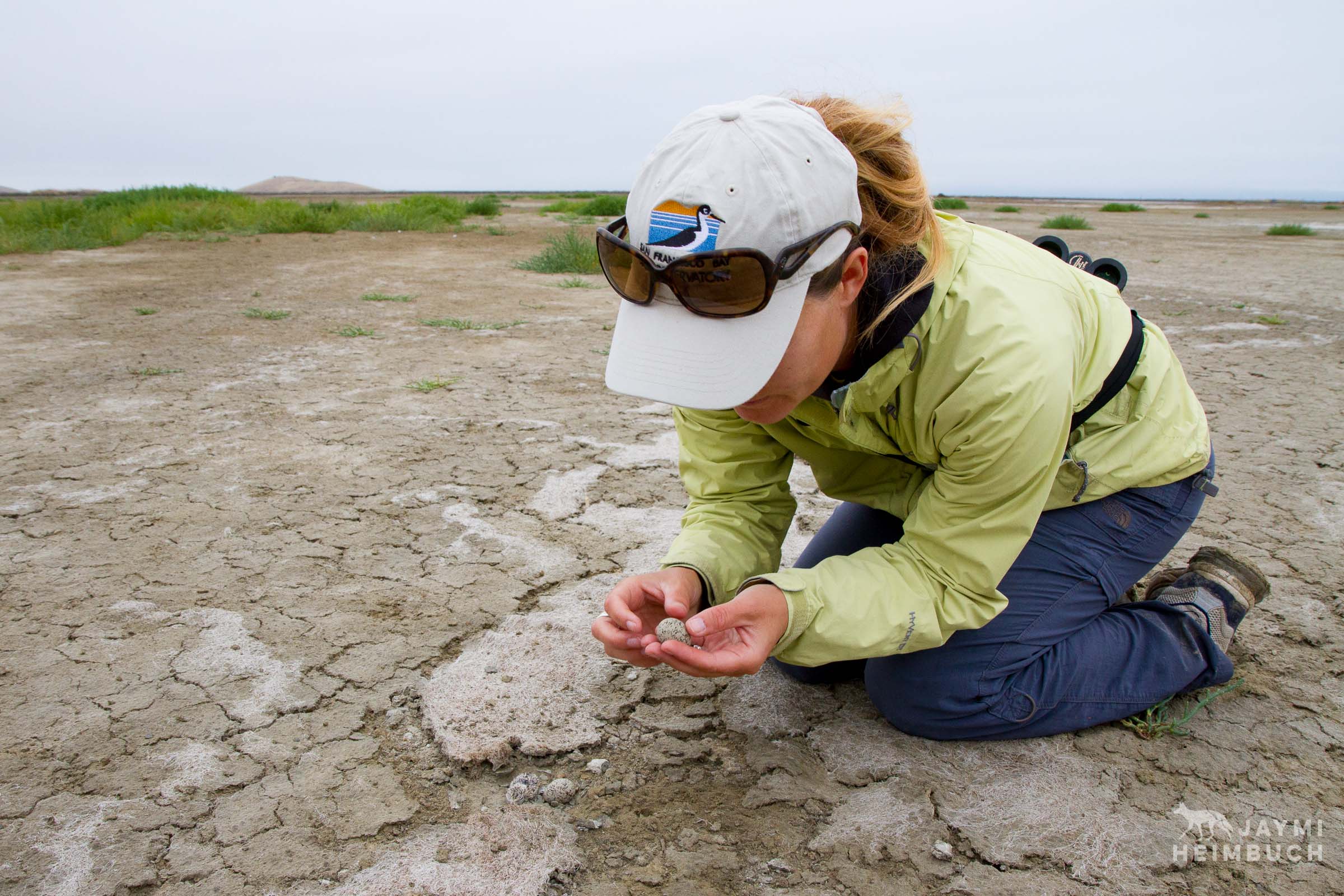
Robinson-Neilson picks up one of the eggs at a western snowy plover nest, which is little more than a clutch of eggs in a small, soft depression in the dirt. This second of three eggs shows signs of hatching.
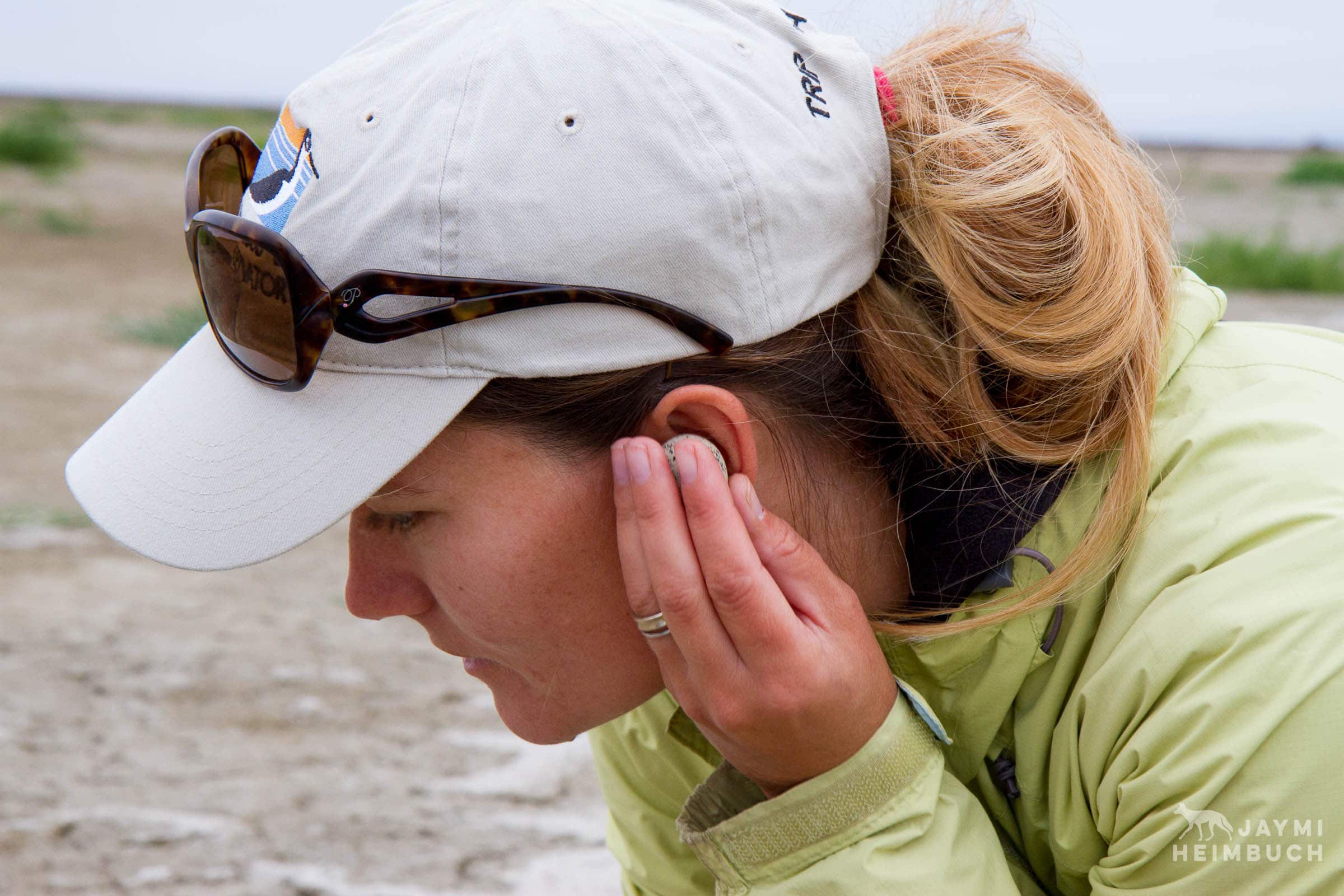
Robinson-Neilson holds an egg to her ear, listening for any sounds that might tell if the chick inside is ready to work its way out.
When we arrived, the second of the three eggs started to move, a definite sign that the chick inside was ready to hatch. Caitlin covered up the two eggs while banding the chick so that they would stay warm. The mother was circling us, again at a distance of about 30-40 yards. She was trying a well-known strategy for luring predators from the nest. Moving in short bursts, she would drag her wing along the ground as she ran, pretending it was broken. It makes the adult look like a more tempting meal to predators than their offspring. When this failed to work with us after several attempts, she stood watching and making alarm calls, waiting for us to be done.
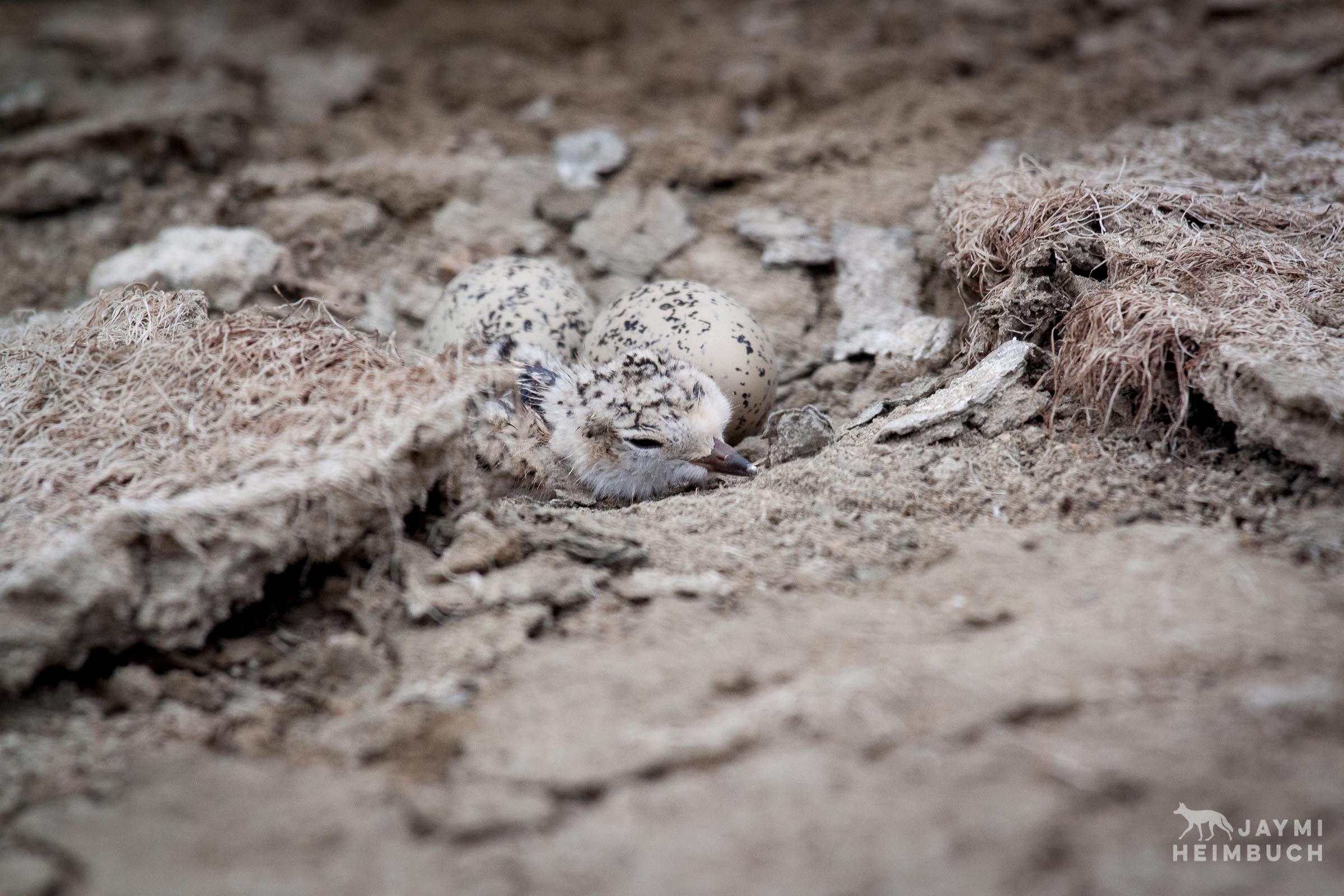
The tiny western snowy plover chick has feathers with similar coloration as its egg, keeping it camouflaged while it rests, warms up, and gathers strength for getting up tp join its parent.
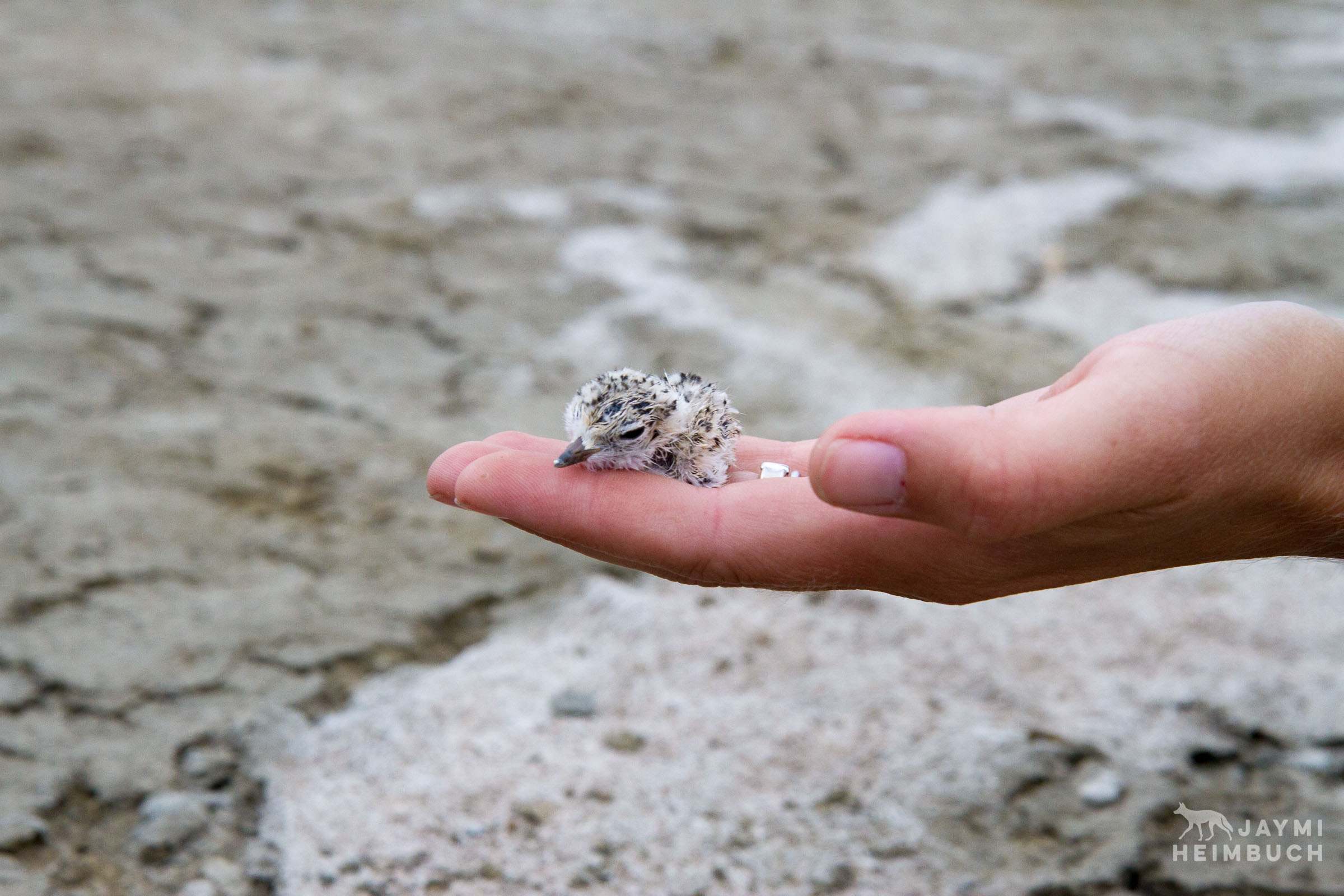
The western snowy plover chick is nearly dry and ready to be banded.
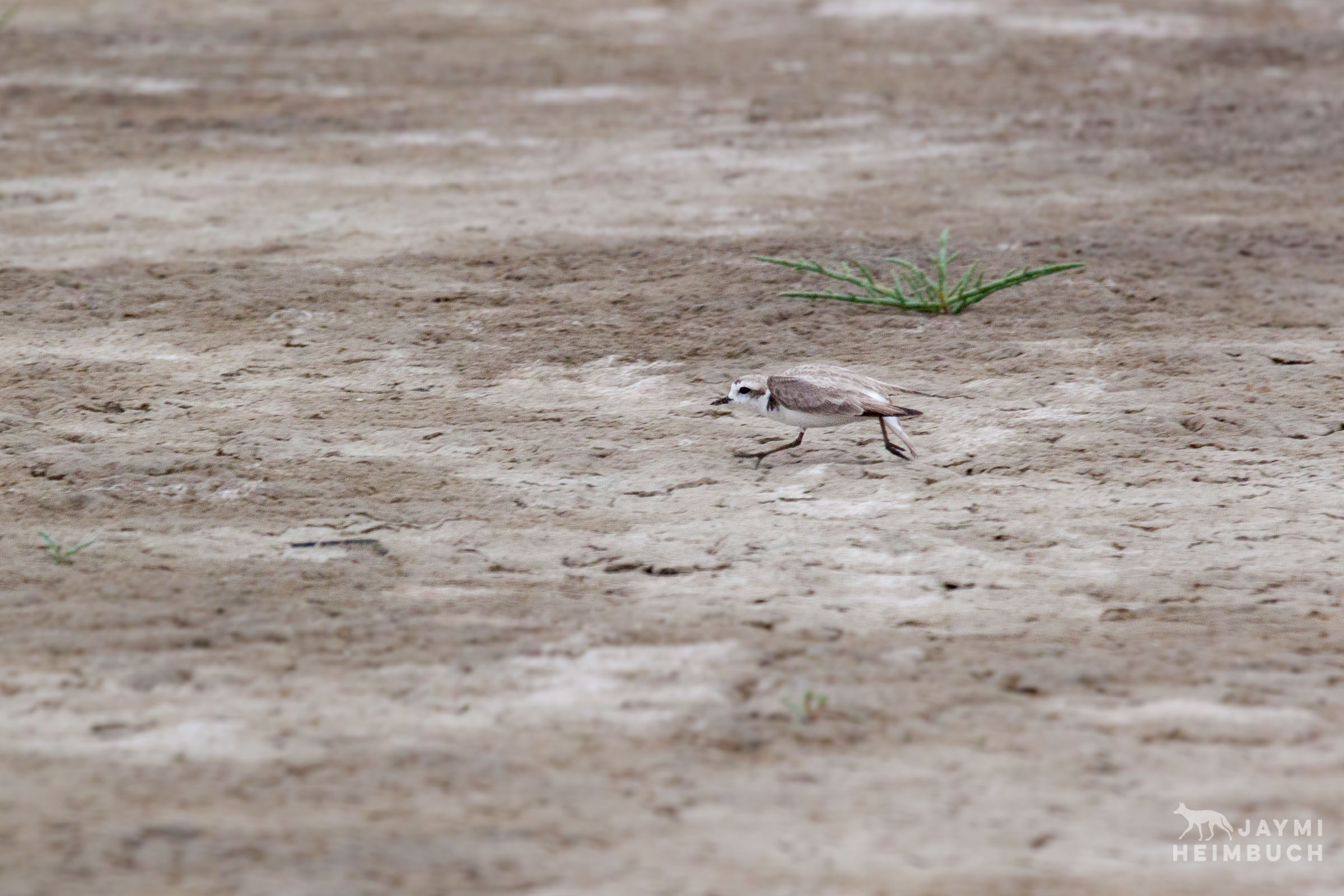
The adult stays nearby, making short runs while dragging its wing as a ploy. It hopes that by faking an injury, it can lure predators (as in, us) away from the nest for a more tempting meal.
Robinson-Neilson opened her tool box to reveal the miniature bracelets, soldering iron, tape, and other necessities for banding. A snowy plover chick receives bands on each leg with a specific number and color pattern that will be unique to that individual bird. This way, someone identifying the bird later on can know exactly which individual it is and track it back to where it was born, its age, and other vital information.
The bands are sized specifically for snowy plovers. Because the plovers are born with legs that will stay approximately the same width for their entire lives, there is no concern that the birds will outgrow their bands. Carefully, each band is slid onto the legs, sealed, and wrapped with racing stripe tape for the needed color combination.
Robinson-Neilson gets everything in order for banding, and meanwhile places a cloth over the remaining eggs to keep them warm while she works.
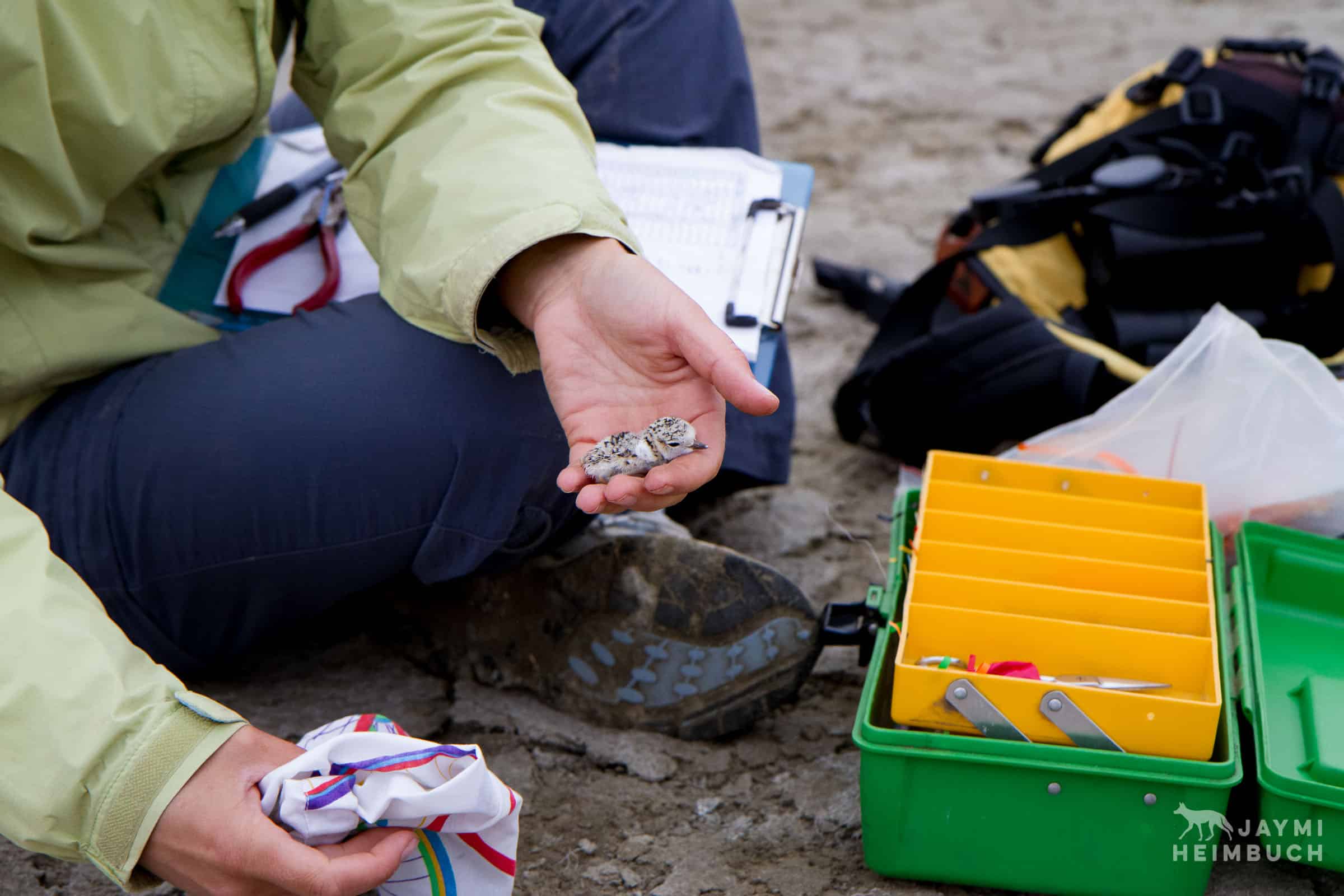
Robinson-Neilson holds the fragile chick with the utmost care while working with it. The safety of the bird is her primary concern.
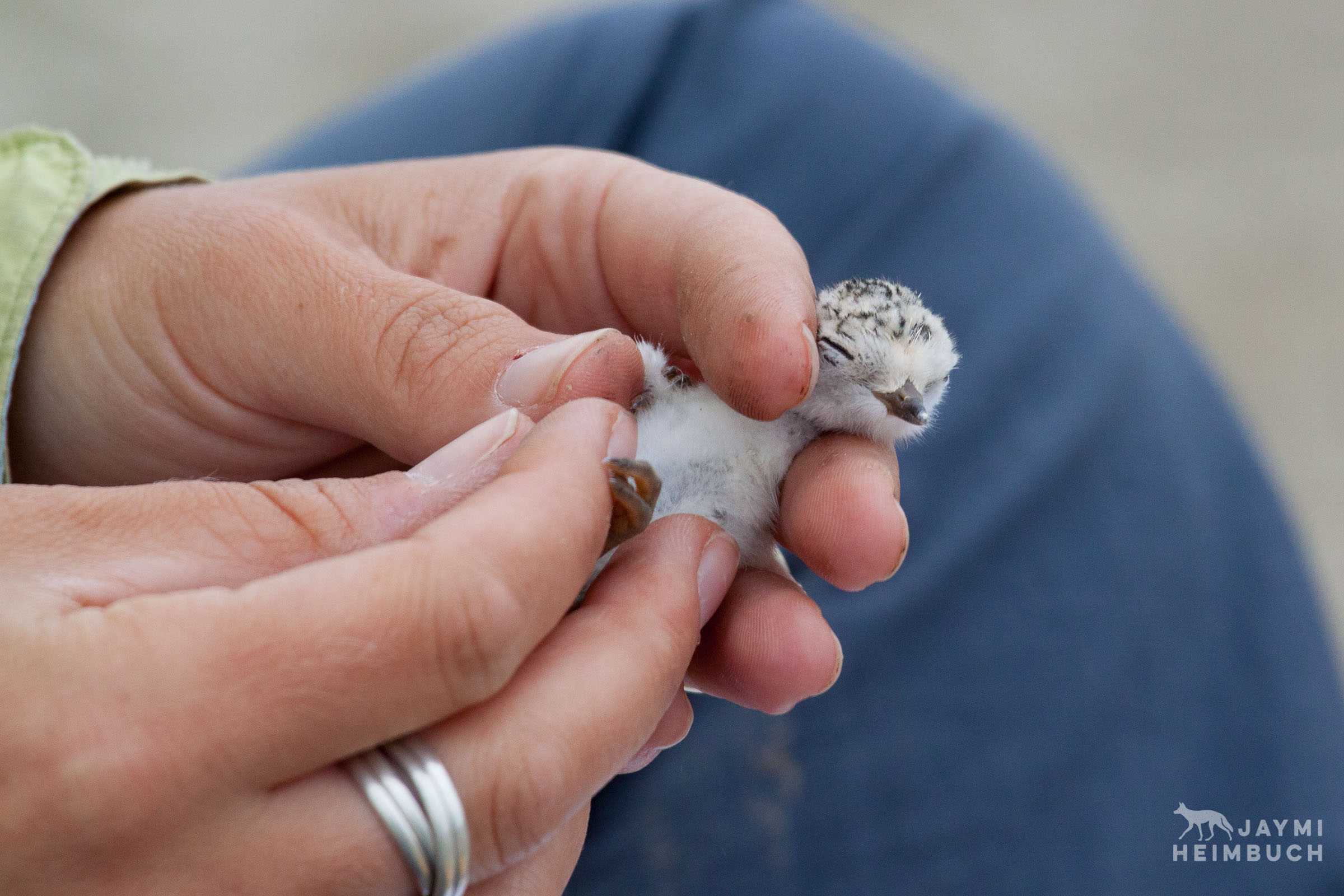
A quick and very careful touch with the soldering iron seals the bands. They will then get a small wrapping of race car stripe tape for their color code and to make them extra secure.
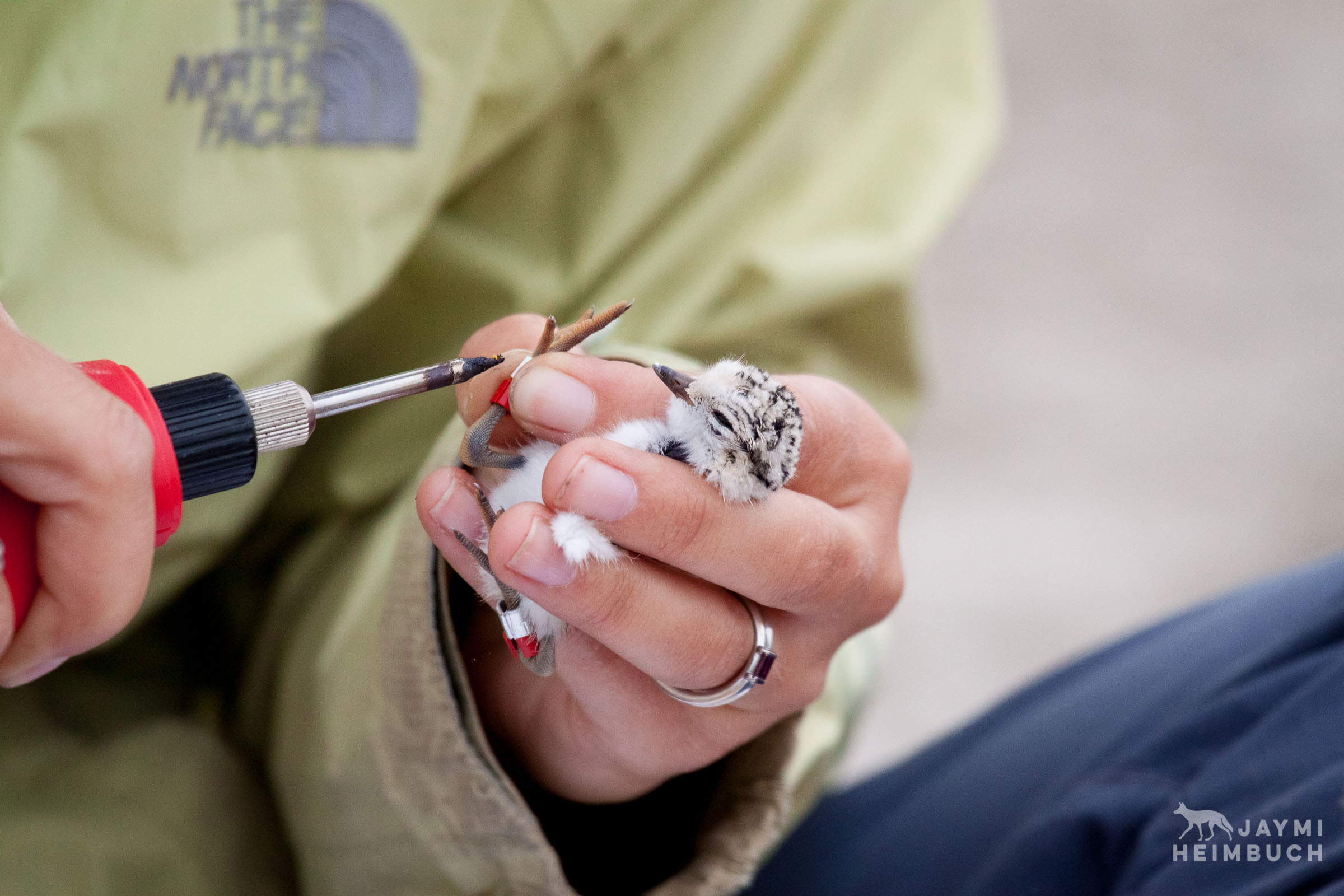
As Robinson-Neilson finishes up her notes on the chick, it sneaks up into the cuff of her sleeve to get extra warmth.
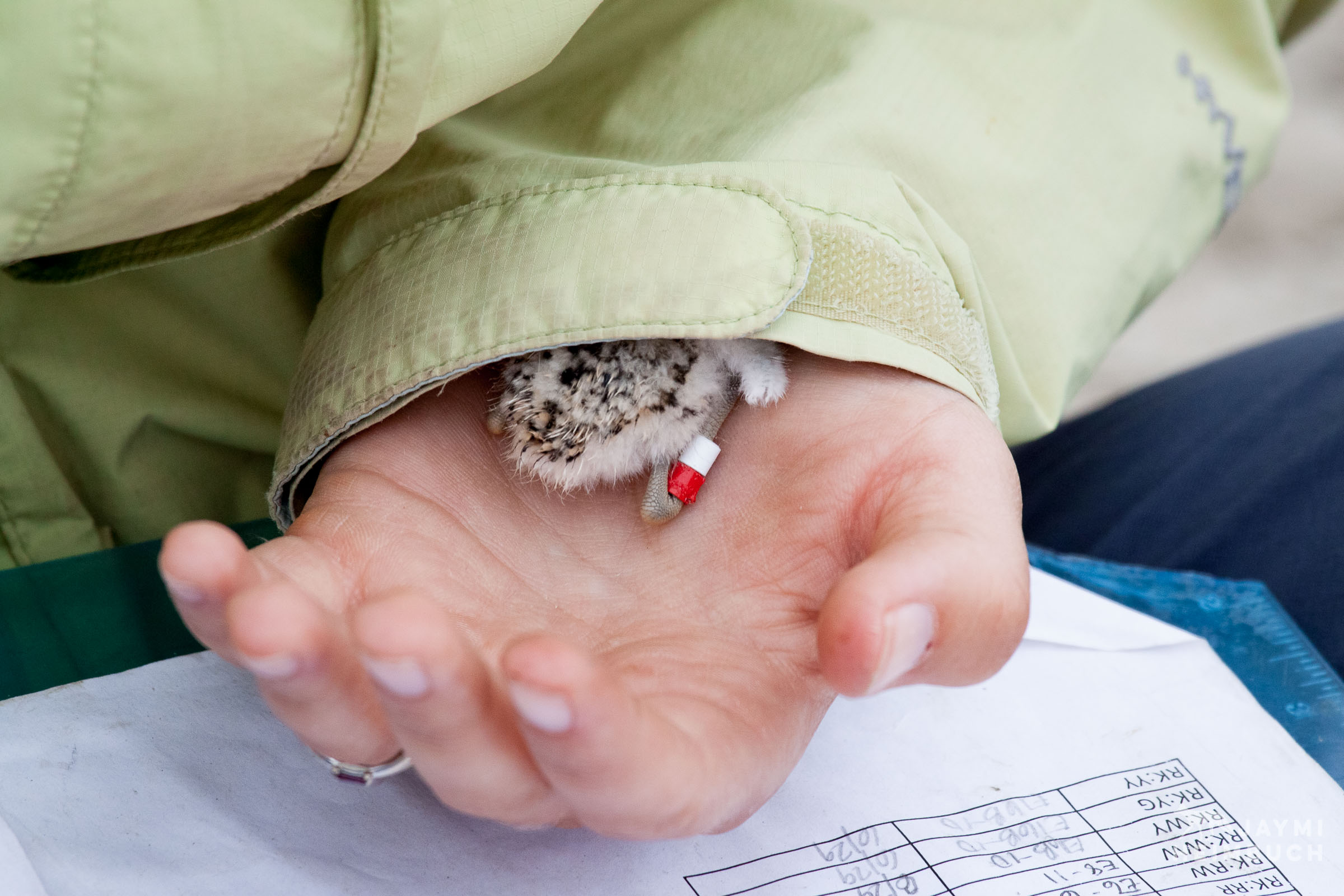
As Robinson-Neilson completed banding the first chick, she lifted the cloth that was keeping the other eggs warm and we saw that the egg that was rolling around when we arrived was now cracked open. We watched as the second chick emerged from its shell, so wet and fragile that it is a wonder such a tiny being is capable of the feat.
We wouldn’t be banding this chick. We had already spent long enough at the nest and didn’t want to stress the adult plover further. Plus, we would have had to wait for the second chick to rest a bit and dry off before handling it. We watched for just a few moments and then left so the family could huddle up together and wait for the third sibling to arrive.
Even though we would band just one chick from this nest, that is considered a success. Often times, the tiny window of 2-3 hours between eggs hatching and chicks already leaving the nest is something the researchers misses entirely. There is a good deal of luck involved in banding these little birds!
Western snowy plover chicks stay with a parent for about a month before heading off on their own, but it isn’t the mother that raises them. They will usually stay with their father while the mother heads off a few days after the eggs hatch to find another mate and hopefully have a second clutch of eggs. For a threatened species, females being able to bringing up two broods each breeding season is a boon.
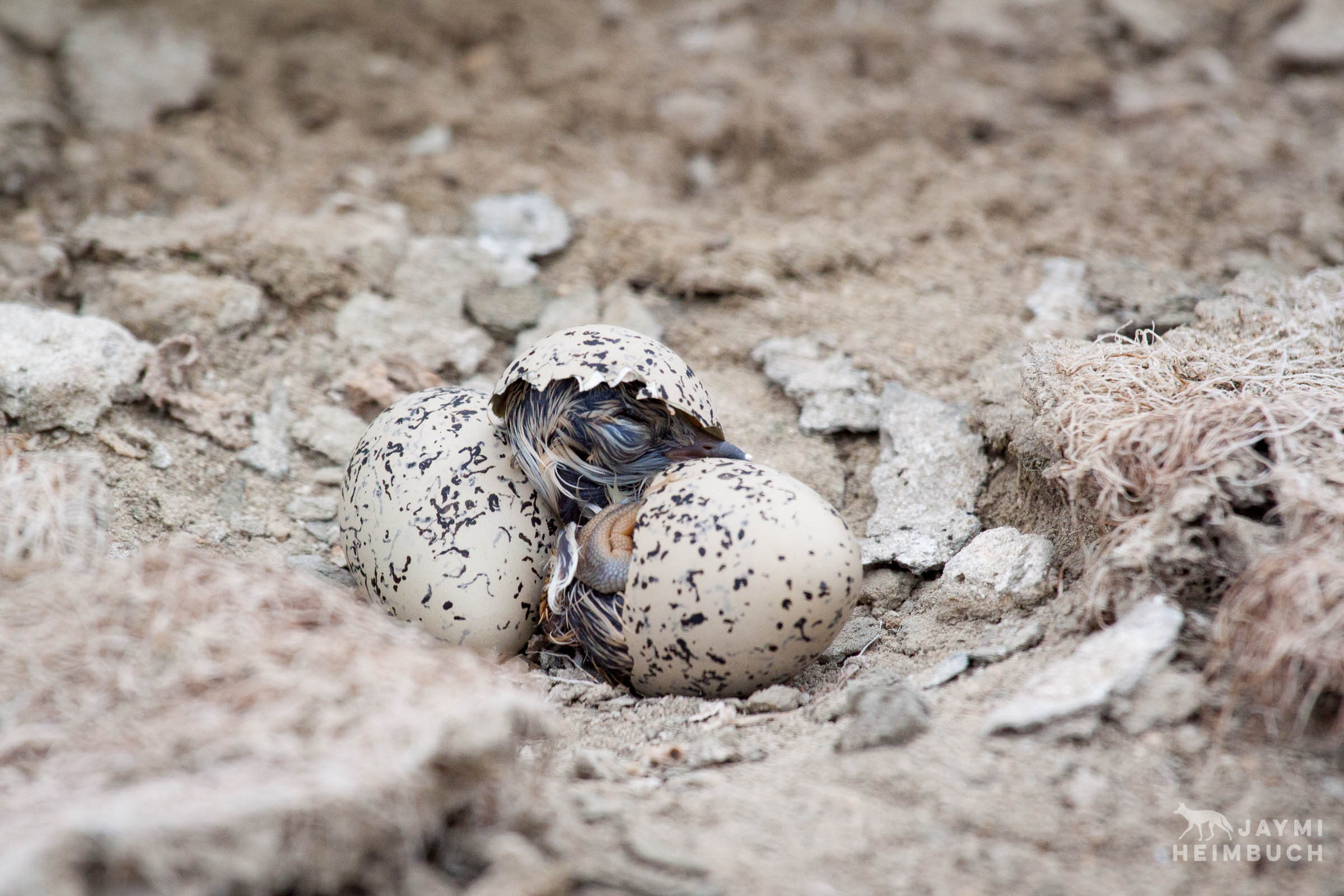
While the first bird was being banded, the second chick began to hatch
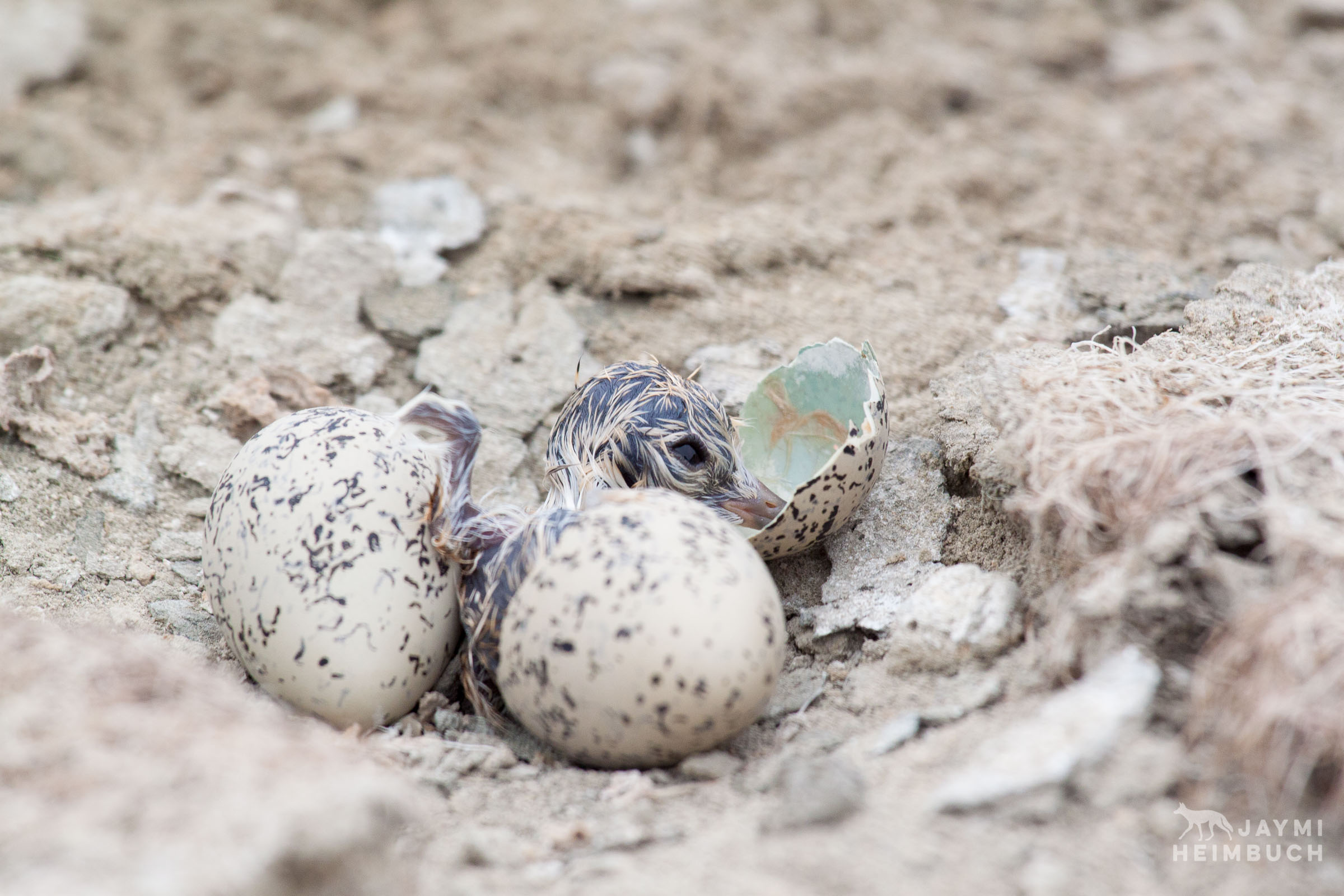
Breaking out of a shell is a mighty effort for the little birds.
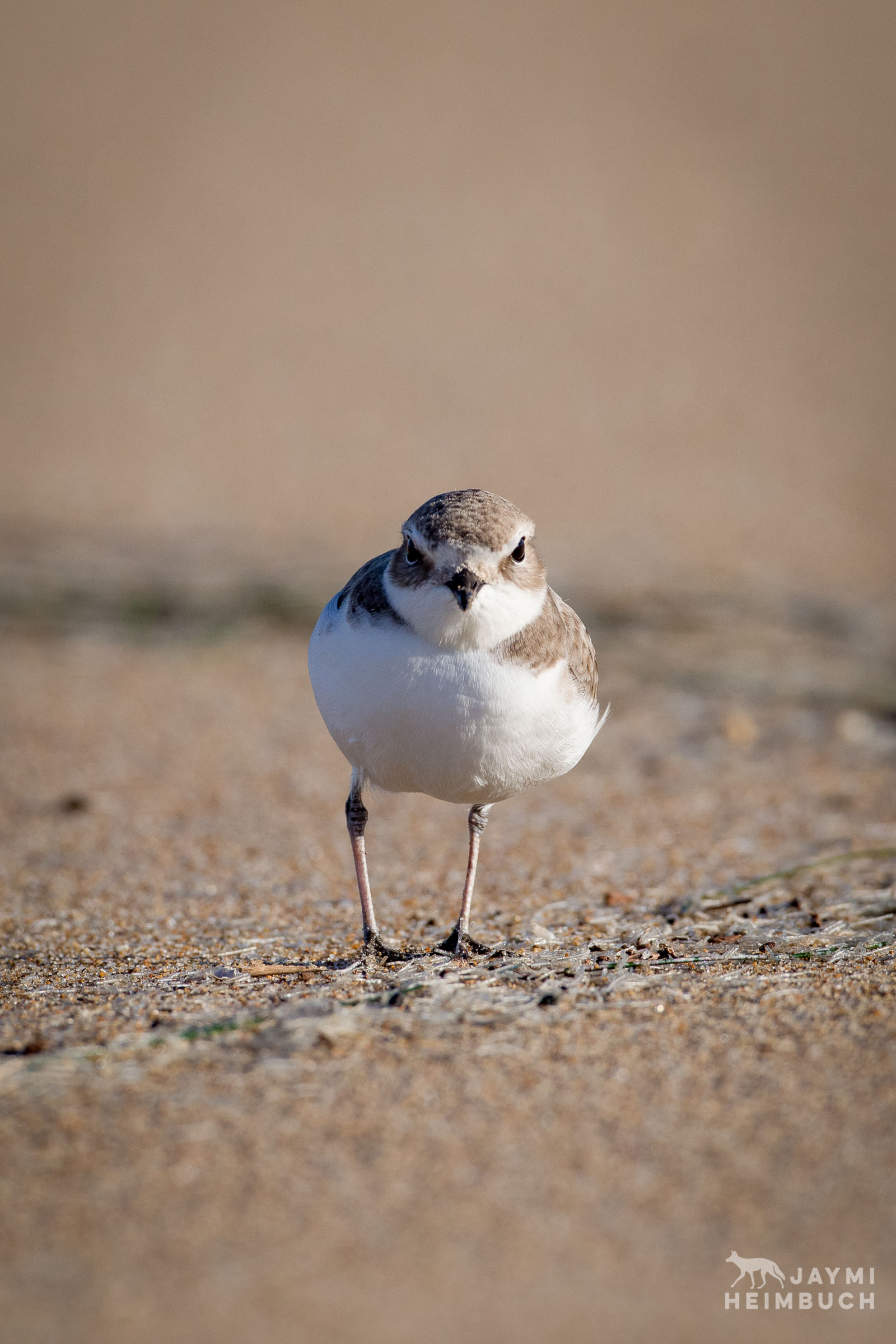
The banding helps researchers know the movement of the birds across seasons, their reproductive success rate during each season, and their survival rates among other information, all of which allows the planning of conservation measures such as what areas are most vital to breeding or wintering birds, the threats they face in the areas, and ways to protect them from these threats as much as possible.
SFBBO has a goal of boosting the population of western snowy plovers to 500 breeding pairs, a number that is considered strong enough of a recovery for removal from the threatened species list. To accomplish this, the organization monitors nests to bands birds to determine hatching and fledgling survival rates, and also to figure out what is predating the eggs and how predation can be prevented. They have set up remote cameras to watch nests from a distance at all hours, allowing researchers to see what animals are breaking or eating eggs, which often includes raves, gulls, foxes and other species.
One strategy the SFBBO tried out after noticing gulls predating the eggs was laying out oyster shells all over nesting areas to help further camouflage the eggs. While this worked well the first year, there wasn’t as much success the following years. But this kind of creativity is exactly what the SFBBO is using to help reach the goal of 500 breeding pairs.
Banding may also help to solve mysteries about changes in behavior. For instance, Bay Nature reported in June of 2013 about the return of nesting snowy plovers to Stinson Beach after a three-decade disappearance. But all was not normal among these breeding birds.
Lynne Stenzel of Point Blue told Bay Nature, “Several aspects of this nest were unusual. First, there were five plovers in close proximity while the eggs were being laid; usually pairs are territorial around their nest. Observers identified three of these birds as females (two wore color bands); the other two were brightly plumaged males. Then, several days after the nest held the usual three eggs, a fourth egg appeared; this is uncommon though not unheard of. And two different plovers, both presumed females, took turns on the eggs for part of the 28-day incubation period. Finally, both males disappeared from the area before the eggs hatched; in snowy plovers, the male usually stays and tends the chicks.”
Bay Nature writes, “The biggest puzzle was that a seeming female assumed the parenting duties at Stinson Beach this year. While plover mates commonly share in incubating eggs, the female normally abandons the nest near hatching time; she may then fly off to breed again elsewhere. The mystery plover at Stinson, after tending the one chick that hatched, has now left the scene. There’s still a chance to verify its actual gender, though ‒ because it is color-banded.”
Using the bands, the researchers knew that the plover was “go:go” meaning green over orange bands on both legs. With this information they knew who the bird was and could also put a call out for birders to watch for this particular plover to see where it was and if it started another nest so the sex could be confirmed (not something that can be done when banding a chick).
The bright color of the bands makes it easy for birders to spot and record individual birds. The information is invaluable when birders report sightings, alerting researchers to where their banded birds are showing up so they can be monitored. Because snowy plovers live an average of only about three years, every sighting is important.
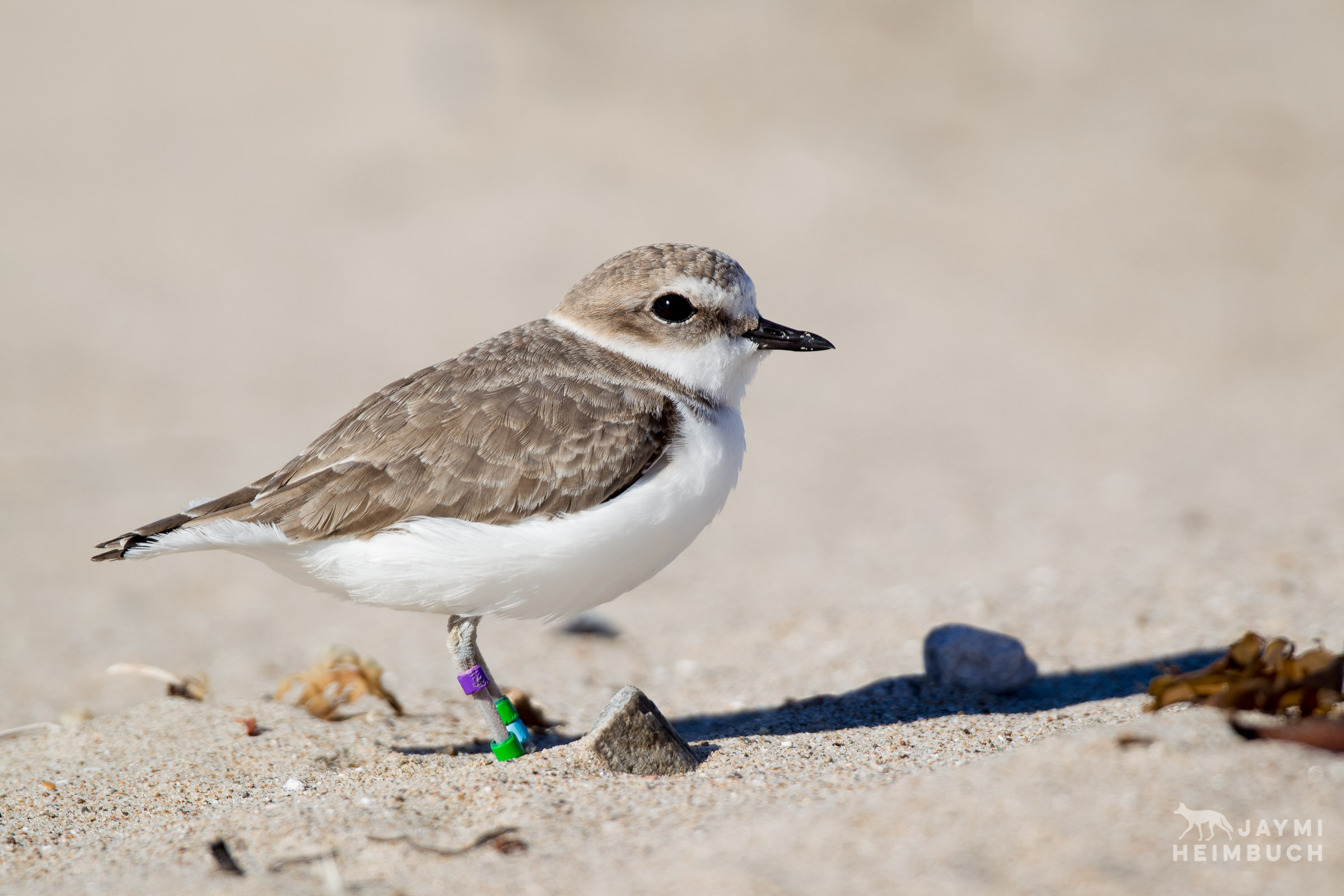
WesternSnowyPlovers.org writes, “Snowy plovers have natural predators such as falcons, owls, raccoons and coyotes. There are also predators that humans have introduced or whose populations they have helped to increase, including crows and ravens, red fox, and domestic dogs. Humans can be thought of as predators too, because people drive vehicles, ride bikes, fly kites, and bring their dogs to beaches where the western snowy plover lives and breeds. All of these activities can frighten or harm plovers during their breeding season.”
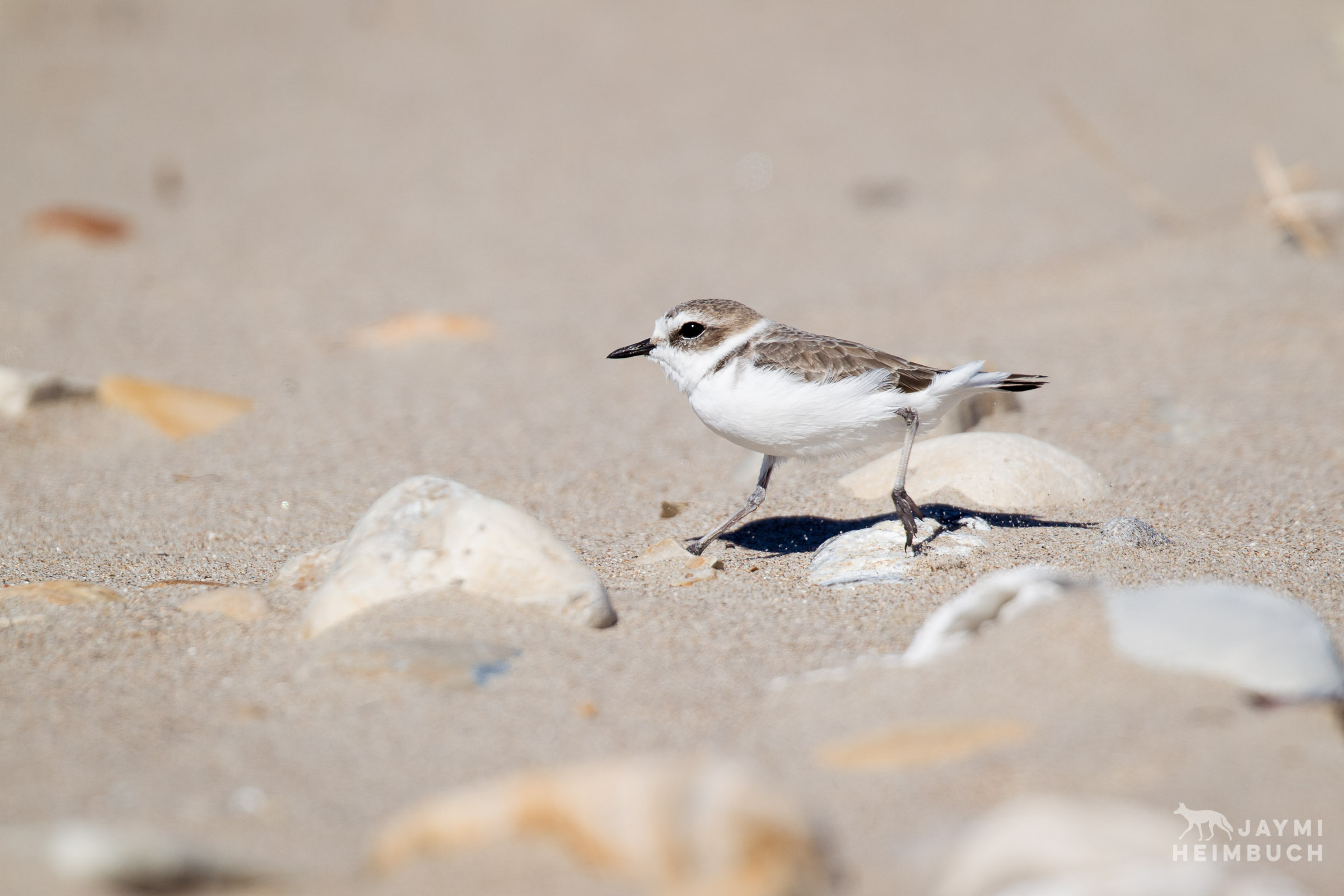
Ways you can help the snowy plover recovery:
Be aware of plover nesting or wintering areas and stay clear. Plovers need all the space they can get in what little habitat they have left. During nesting season they need to feel secure to keep on the nest and not abandon their eggs. Additionally, eggs trampled by humans who don’t notice nests is one of the causes of nest failure. Meanwhile, during wintering months, plovers need to feel safe foraging to build up the fat reserves needed for migrating and breeding. Keep dogs on leashes when shorebirds of any variety are around as snowy plovers are often mixed in with flocks of other small shorebird species.
Golden Gate Audubon notes, “Because Snowy Plovers live in areas that are also popular locations for human recreation, there is often the potential for frequent disturbance. Recreational activities such as jogging, dog walking, ball games and kite flying are common sources of disturbance. There are natural sources of disturbance too, such as crows and ravens that are attracted to human refuse”
Of note is the fact that negative human influence on snowy plover populations is more than about simply diminishing the amount of habitat the plovers have, but also the protection within the habitats. Point Blue notes that, “Since 2002, we have seen ravens colonize the coast from San Mateo to San Luis Obispo counties by exploiting human infrastructures and food sources. Once absent from these areas, now ravens destroy plover nests along many miles of beach.” As is the case with most sensitive wildlife species, more than “just enough” space is needed to fully protect a species — a buffer zone between humans and wildlife is invaluable.
Balance is possible, though. Golden Gate Audubon adds, “Managing some seashore areas as passive recreation areas can greatly reduce disturbance to shorebirds while providing recreational opportunities such as walking, beachcombing, wildlife viewing and photography.”
And of course one significant way you can help is to report sightings if you are in western snowy plover habitat and spot a banded bird. Record the color combinations by leg, top to bottom. For instance, the plover in the photo above would be “right leg: blue over red; left leg: red over yellow”. You can send your reports to SFBBO.
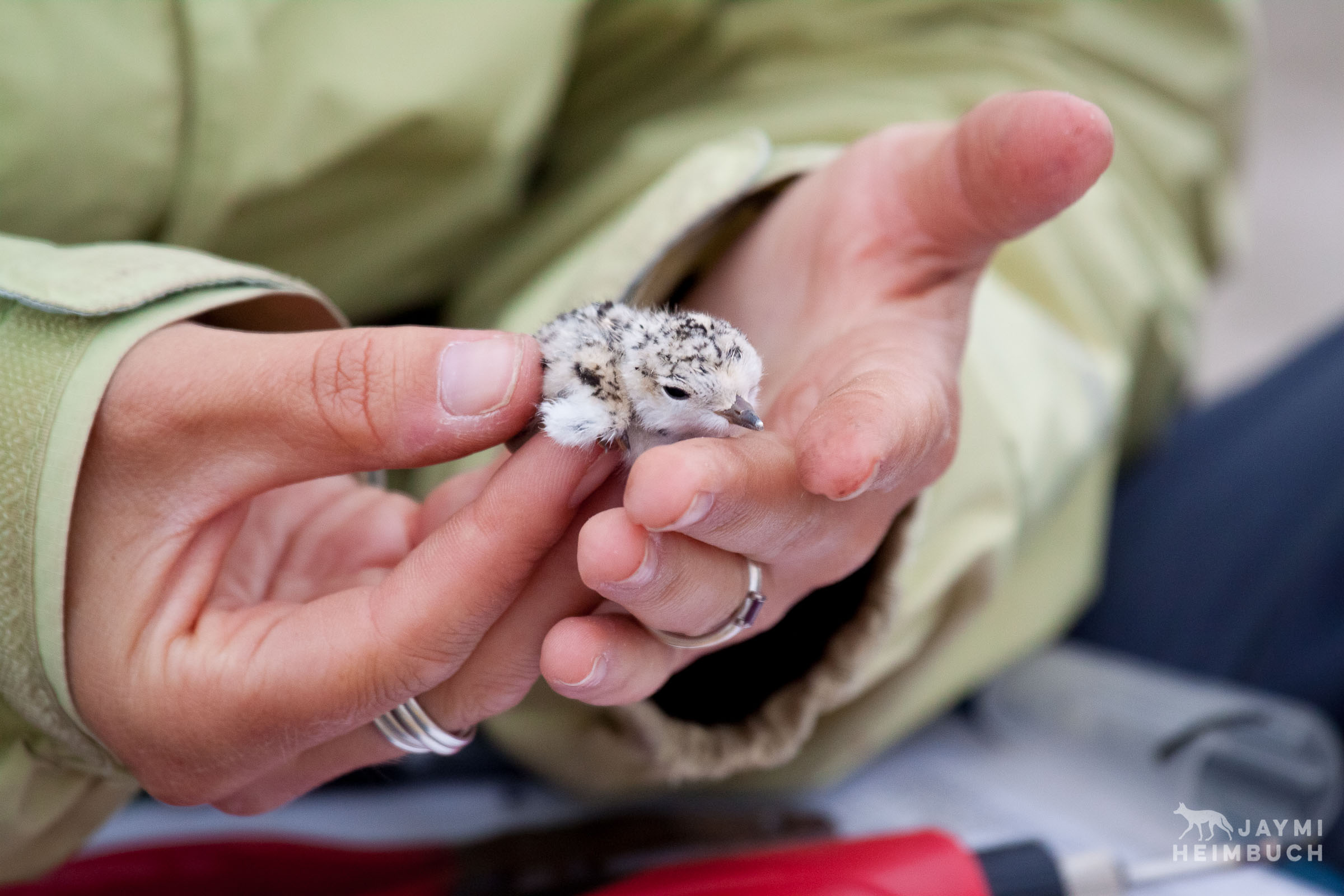
With luck and hard work — and plenty of banding and tracking of individual birds — hopefully the western snowy plover can rebuild their population to levels that will get them off the threatened species list.
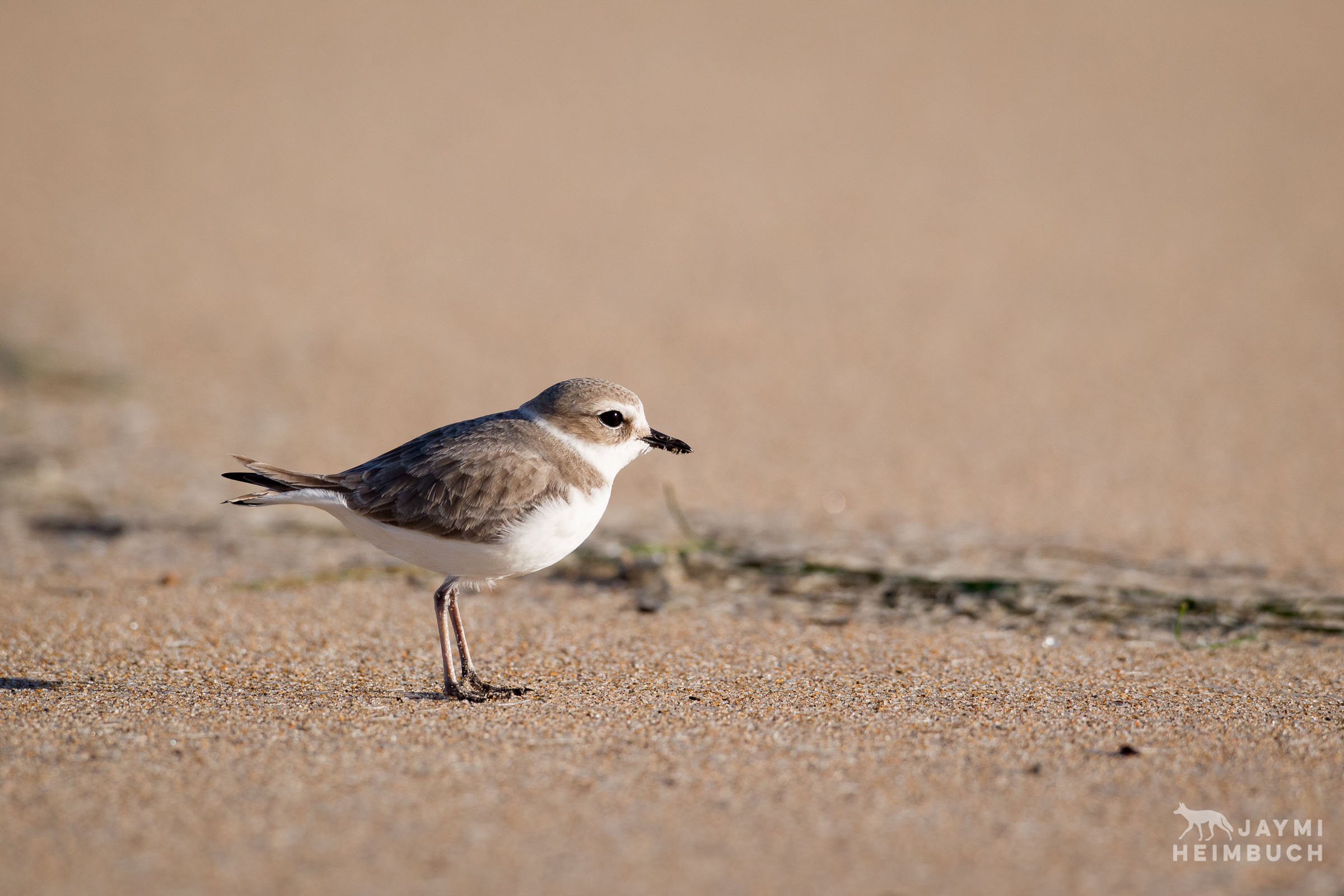
Originally published March 2015
[mashshare]

